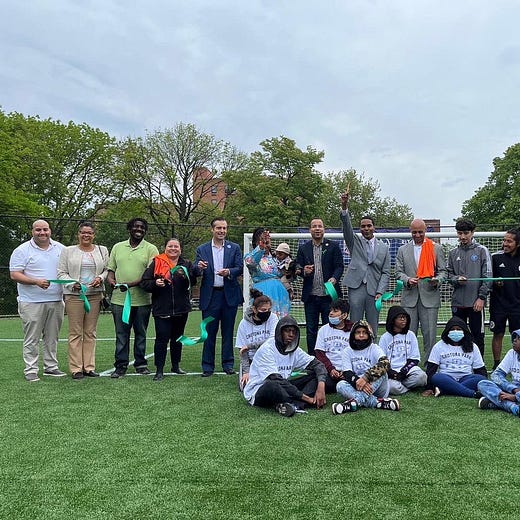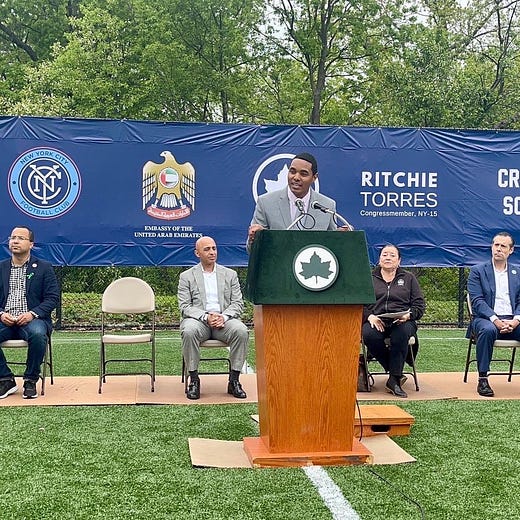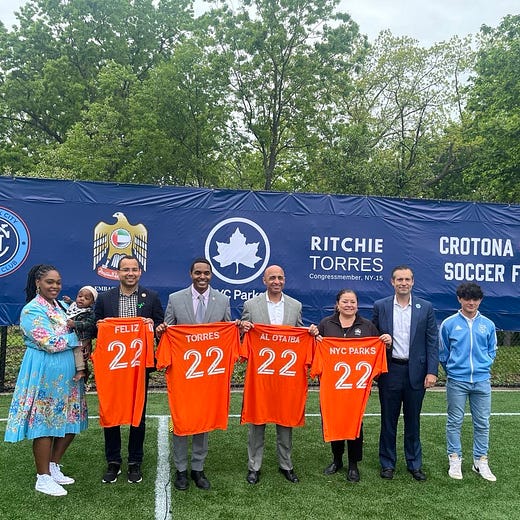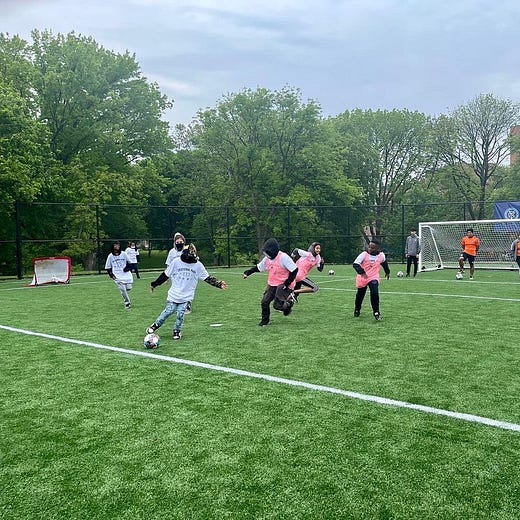For Abu Dhabi: Why CFG Intentionally Scuttled NYCFC's Stadium At Flushing Meadow
Why did it take so long for NYCFC's stadium? Justin Egan examines how the club's stadium woes were set in motion after stadium plans in 2013 were scrapped to protect the image of Abu Dhabi.
On May 21, 2013, Ferran Soriano, flanked by Major League Soccer commissioner Don Garber and New York Yankees president Randy Levine, was in New York City to announce the next step in the City Football Group’s (CFG) plan for global expansion. Unlike the franchise across the Hudson River in New Jersey, New York City Football Club was to be the true team within the city proper. It was hard not to see the dollar signs in their eyes.
In between generic talking points, self-congratulatory platitudes, and showing Levine how a soccer ball works, Soriano made a promise. The Manchester City and CFG CEO vowed that the new ownership group would build a stadium inside New York City and the club would only “play in a temporary location for two years, maybe three.”
“New York City FC will have a permanent home in the city in the great traditions of New York sports and world soccer.”
Ferran Soriano, City Football Group CEO
That optimistic timeline was a product of CFG being handed a nearly complete stadium bid for a site in Flushing Meadow-Corona Park by the league. In November 2012, Garber described the MLS-led project as “at the finish line” and touted the political support of Mayor Michael Bloomberg, Governor Andrew Cuomo, and other local politicians dead set on bringing professional soccer to Queens.
However, by July 2013, the prospects of an NYCFC stadium in Flushing Meadow were completely dead. The club quickly pivoted towards a site near Yankee Stadium in the Bronx, trying to jam through a deal before Bloomberg left office – but by the summer of 2014, those negotiations had ceased as well.
While it seemed like CFG missed a tap-in, the collapse of the stadium project at Flushing Meadow was not due to incompetence. Internal discussions show that CFG executives believed a stadium at Flushing Meadow was “achievable”, but made the cold, calculated decision to scuttle attempts to push a stadium plan across the finish line.

Before CFG even finalized its purchase of NYCFC, top executives were strategizing the best way to secure a stadium in New York City. These discussions became public record after a group of hackers believed to be affiliated with a regional rival (and Paris Saint-Germain owner) Qatar leaked emails from Yousef Al Otaiba, the United Arab Emirates (UAE) ambassador to the United States, in June 2017.
To comprehend why NYCFC’s stadium plans were getting caught up in geopolitical controversy, you need to understand what exactly CFG is and what their goals are. On paper, CFG is owned by a member of the Abu Dhabi royal family, Sheikh Mansour. However, Mansour is not just your run-of-the-mill Middle Eastern oil billionaire. His brother is Sheikh Mohammed bin Zayed (MBZ), the President of the UAE and the ruler of Abu Dhabi – the richest and most powerful of the seven emirates.
While it is easy to write off CFG as either a multi-billionaire's expensive play-thing or a very successful global sports conglomerate, Amnesty International has accused the UAE of using CFG to “sportswash” its “deeply tarnished image” and human rights record.
Critics say that Abu Dhabi’s investment in CFG and targeted community services initiatives are really a coordinated and sophisticated public relations ploy to help increase power and influence in important international cities like New York, Manchester, Melbourne, and Mumbai while also cleaning up the UAE’s international reputation in regards to its regressive policies in areas such as repression of political dissidents, women, the LGBTQ+ community, and migrant workers in addition to responsibility for the humanitarian crises in Yemen and Libya, and helping Russian oligarchs evade sanctions after the invasion of Ukraine.
Nicholas McGeehan, a founding director of FairSquare Research and Projects who previously worked as an expert on the UAE for Human Rights Watch, Amnesty International, and Mafiwasta, told The Outfield that he believes that Mansour – who has only attended a single Manchester City match despite controlling or owning stakes in 11 different football clubs – is just a front man for MBZ and Abu Dhabi.
McGeehan points to the fact that the people running the show at CFG are not lieutenants of Mansour, but of MBZ. Khaldoon Al Mubarak is CFG’s chairman and MBZ’s right-hand man. Simon Pearce, who cut his teeth as a public relations and communications executive at the notorious firm Burson-Marsteller, is on CFG’s board of directors and serves as Abu Dhabi’s head of strategic communications.
In a 2017 interview with Empire of Soccer, McGeehan explained the genius of the scheme, which also includes relationships in New York City with New York University, the Guggenheim Museum, members of Congress, and the New York City Mayor’s Office, to increase the soft power of the UAE:
EoS: [NYCFC] also formed City in the Community, which is leading a handful of community service initiatives along with MLS, the Abu Dhabi consulate and the mayor’s office as partners. How have you seen City and Abu Dhabi use community service, use football toward building a reputation and what is the end goal?
NM: It’s good PR, it presents them as being wholesome benefactors who are trying to contribute to the welfare of these communities. Particularly when kids are involved, it’s a fantastic photo op and it makes them look good. The other thing they’ve done is the investment in children’s hospitals in Washington and the U.K. You don’t want to denigrate that sort of thing, it’s great that they want to help kids but I don’t think people should be so naïve to see that it furthers their interests as well.
EoS: That seems to be the catch to it all. We’ve seen them build fields and contribute culturally in New York aware that this is to advance their interests at the end of the day, but we’re also aware of their record of abuses. So how should people try to square the two?
NM: They’re absolutely related. Successfully carrying out your foreign policy and developing these centers of influence is also part of your business policy because these guys are as much businessmen as they are statesmen. The foreign policy and business policy is almost intertwined. If you’re locking up, torturing and keeping people enslaved, if you are involved in the greatest humanitarian catastrophe currently ongoing, which is war in Yemen, then it’s important that these issues not be how you’re known and defined. You need something else to define your country, your image and the way to do that is throw millions at PR and to present yourself as something else and they do that incredibly effectively.
They hope people don’t care or don’t notice because they’d blame them for spinning tricks and smoke-and-mirrors. If they do notice, then it’s something happening far away and there’s nothing that we can do about that. It’s a challenge because when you’re that well-funded and that smart about how you spend your money, it’s difficult to push back against that. The genius of funding soccer is that you’re funding something that people are involved in because it’s not political because it’s an escape of the humdrum and the horrors and everything. That’s why people enjoy sport, to get away from all the crap.”
For the UAE, NYCFC is a useful tool to potentially wield long-term influence in New York and American politics. Last year, President Biden, former President Bill Clinton, and former Secretary of State Hilary Clinton all tweeted their congratulations when NYCFC won MLS Cup, but none have done the same this season for LAFC. Just this weekend, the Washington Post reported that “U.S. intelligence officials have compiled a classified report detailing extensive efforts to manipulate the American political system” by the UAE and “include illegal and legal attempts to steer U.S. foreign policy in ways favorable to the Arab autocracy” with a source telling the Post that the report references Al Otaiba.
The leaked Al Otaiba emails involving NYCFC were written in early May 2013 and showcased a discussion between Soriano, Pearce, and NYCFC vice-chairman and CFG board member Marty Edelman as they were getting ready to brief Al Mubarak on the situation in New York. The exchange gives tremendous clarity of not only the purpose of putting a team in New York, but also how that purpose conflicted with getting a stadium done in Flushing Meadow.
The emails clearly show that although “achievable” there were major uncertainties involved in securing the stadium site at Flushing Meadow that would put Abu Dhabi and the UAE under a “storm of controversy and scrutiny” due to exposure on issues such as ”gay, wealth, women, Israel” and could “put at risk hard-earned and limited US political capital and public goodwill.” The possibility of the stadium fight doing “real damage to UAE [and Abu Dhabi] reputation” seemed to be the biggest driving factor in their decision-making.
The directors were ready to present several options to Al Mubarak including walking away from purchasing the expansion franchise from MLS, suspending the purchase until the league successfully secured the stadium site, and going all-in on Flushing Meadow. In the end, they chose the fourth option: get the franchise but find a temporary venue for three years “until team is locally accepted reducing controversy.”
“My view is if we do it that way, in three years’ time we could be talking about how the initiative has finally allowed us (UAE) to be fully engaged in NYC.”
Simon Pearce, CFG Board Member & Abu Dhabi’s Head of Strategic Communications
“It does seem that we are taking on water at the moment. The fastest and safest approach is what we need. Otherwise the damage might be too much.”
Yousef Al Otaiba, UAE Ambassador to the United States
So with that choice, Abu Dhabi and the UAE got their team and soft power foothold in New York City, but ultimately lost out on a stadium in Flushing Meadow. It is uncertain how much CFG’s other allies in the Mayor’s Office, MLS, and the Yankees knew of these foreign geopolitical considerations.
When The Outfield asked NYCFC CEO Brad Sims in 2020 about CFG’s concern that NYCFC's stadium search could expose CFG to criticism for Abu Dhabi's politics on "gay, wealth, women, Israel" and whether ownership kept the club from being more transparent with its city and fans, Sims wanted to avoid discussing anything UAE-related, but was sure to mention the City in the Community program:
As it pertains to UAE, that’s not something I can comment on. I’m not familiar with that quote or anything that you said, and I’m not an official spokesperson for UAE. All I can talk about is NYCFC and my role, and from that standpoint, all I’ve seen from our organization here in New York and in Manchester and in other markets, I’ve seen nothing but incredible amounts of support and resources from our ownership group, from CFG, into local communities and City in the Community, our nonprofit group. It’s been unbelievable the amount of resources and support that they have put toward that.
While CFG’s assessment that NYCFC would only need to play at a temporary venue for three years was woefully inaccurate, the Al Otaiba emails were prescient in one regard: the correct assessment that there was a “lack of viable alternatives” to a stadium in Flushing Meadow.
When NYCFC starts the 2023 season playing at Yankee Stadium among the patchwork of venues it has been forced to string together, it will mark nearly a decade since CFG decided against pushing for the stadium at Flushing Meadow. What was supposed to be three years in a temporary stadium is now turning into eight with many more in sight.
Ironically, after years of working local politicians, building a dragon’s hoard of soccer fields throughout the five boroughs, bringing home the MLS Cup, and multiple failed attempts at other sites, the NYCFC stadium saga is back to where it began in Queens literally right across the street from the original stadium site in Flushing Meadow park.
Why did it take so long? The answer to that question, in part, is 6,844 miles away in Abu Dhabi. ❧
Image: Miguel Gonzalez, Hernan Cortes scuttling his fleet off the Veracruz coast











